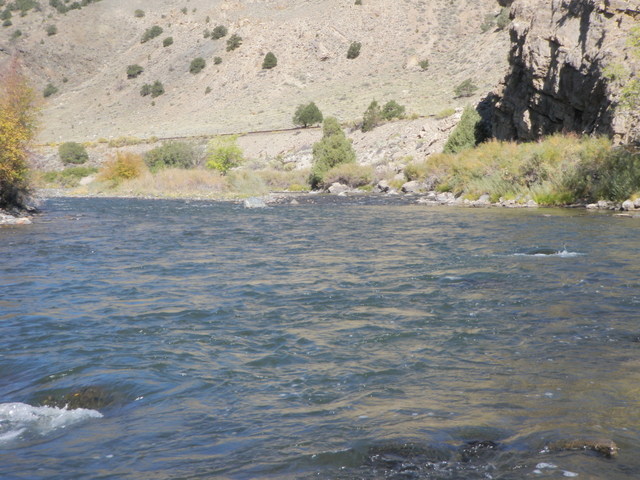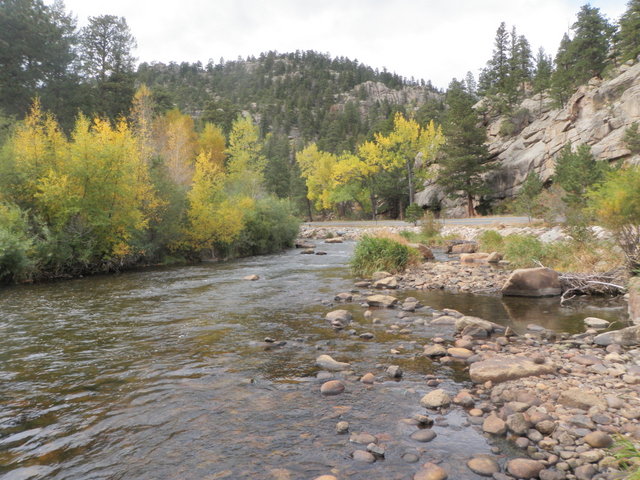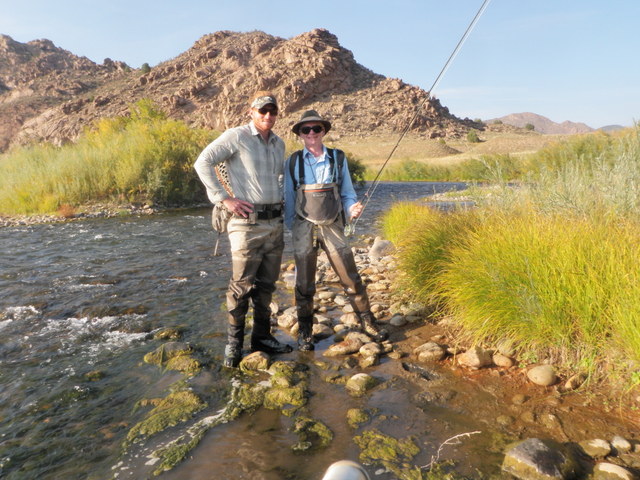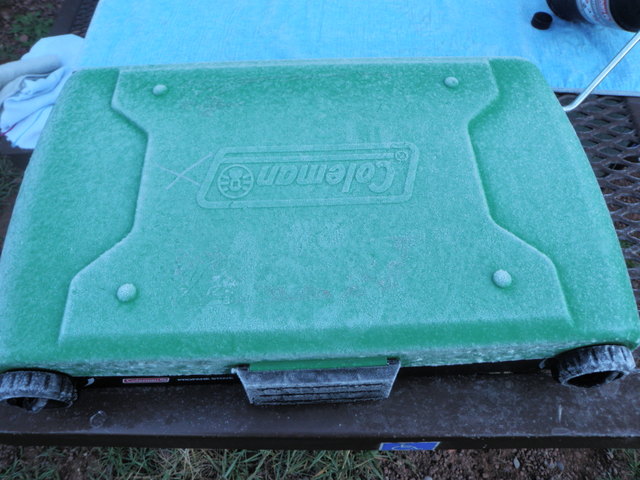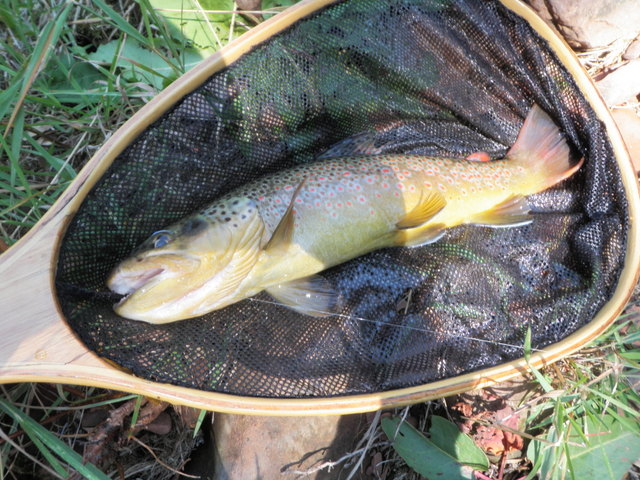Time: 10:00AM – 4:00PM
Location: Fremont – Chafee County Line below Salida
Fish Landed: 26
Arkansas River 09/28/12 Photo Album
Insane. Ridiculous. These are adjectives used to describe my day of fishing on the Arkansas River on Friday. Apparently the rain and cool mid-week weather caused the brown trout in the Arkansas River to put on the feedbag prior to spawning and I experienced some great action. Landing 26 fish was a lot of fun, but that number could have been closer to 40, so the day was a little bittersweet, but even with some disappointment, it was a fabulous day of fly fishing.
I had everything loaded in the car on Thursday night so that I could make an early get away on Friday morning, and was in fact able to depart at 6:30AM. It was still rather dark as I backed out of the garage, but by leaving early I avoided the Denver rush hour traffic and made good time in my trek to Salida. As I reached the top of Kenosha Pass I glanced at the dashboard thermometer and noticed it was 28 degrees. How much could it warm up before I reached my planned destination below Salida? At the top of Trout Creek Pass the temperature climbed to 33 degrees. I wasn’t removing any layers. I passed through Salida and arrived at the pullout on the boundary of Fremont and Chafee County at 9:20 and by now the temperature reached 44 degrees.
I pulled on my long sleeve Under Armour shirt and wore it under my fishing shirt for added warmth. Instead of stuffing my raincoat in my backpack I decided to wear it as an outer layer and wind breaker. I could always remove it if it warmed up and stuff it in my backpack. I transferred my lunch from my insulated lunch bag to my backpack and then climbed into my waders and rigged my rod and I was on my way. This is my absolute favorite stretch of the Arkansas River and I headed for my sweet spot by crossing the river at the tail of the pool below the car and then hiking down the railroad tracks to a position below the small island.
I began fishing 30-40 yards below the island and this was further downstream than I normally begin. Initially I began fishing with a yellow Letort hopper and a beadhead hares ear and made prospecting casts from the bank out to the inner current seam, and that was typically a corridor of 15 feet or so. As I worked upstream along the right bank I landed six decent browns in the first hour between 10 and 11AM. I continued fishing up along the left side of the island, but this proved unproductive, so I circled back to the bottom tip of the island and prepared to move up through the smaller right channel. This stretch is my favorite area of the Arkansas River and historically my most productive. During a trip to this same area in late September 2011, I fished the right channel with a lime green trude trailing a beadhead midge larva and sunken trico with great success. I decided to repeat this approach except I substituted a beadhead RS2 for the midge larva and used an olive deer hair caddis instead of a lime green trude as the top fly. The main thing I was copying was going small on both the indicator fly and the droppers.
Below the long smooth pool I had several hook ups in the short pockets, but the fish escaped before I could net them probably indicating they took the tiny RS2 or trico flies. I did manage to land a couple medium sized browns before reaching the long pool, and I was exuding optimism as I began casting to the low end of the long smooth pool, but this eagerness was misplaced. I covered the pool from left to right and gradually lengthened my casts and checked them high to flutter my flies gently to the surface, yet these careful presentations went unrewarded. When I got to the top of the long pool where there was more current, I decided to revert to what had worked for me in the first hour. I knew there were fish in this area so apparently I wasn’t using the right ammo to attract attention. I went back to the yellow Letort hopper plus the beadhead hares ear and added a beadhead RS2, and this combination produced quite well over the remaining half of the right channel. The browns were hammering the nymphs in the likely locations, but also in nondescript lies such as tiny pockets behind exposed rocks, shallow runs along the edge, and tiny nooks along the bank.
I was on a hot streak when I reached the top of the island as I fished the right channel where there was a fish in nearly every location I cast to, even spots that appeared to be marginal. Could this type of fishing continue for the rest of the day? I decided to work up along the right bank and I was now dealing with the full width of the Arkansas River. I passed through a shallow riffle stretch with no action, but as the water deepened a bit and exhibited more of a riffle character, the fish began to materialize again. I stopped for lunch at 1:30 by a dead log and I’d accumulated approximately 15 landed fish. The action wasn’t as fast and furious as the right channel section, but it was steadily productive, and the average size of the fish improved. Because there was now more casting and more water to deal with, the sudden excitement of a hooked fish was even more rewarding.
After lunch I began to notice an occasional BWO fluttering up from the stream. The sky was clear and blue for most of the afternoon, but a few puffy white clouds blocked the sun for ten minutes or so, and this was enough to provoke some sparse hatching activity. I left the RS2 on my line and managed to catch a few on it, but the beadhead hares ear was probably outproducing the RS2 by 2 to 1. I landed eleven browns between lunch and quitting at 4PM and quite a few were in the 15 inch range and they were quite well fed browns for that length.
At one point shortly after lunch I suffered my third or fourth break off, and I lost all three of my flies. I was pretty pleased with the performance of the yellow Letort hopper as it duped three fish so I replaced it with another. However, I was depleting my valuable inventory of beadhead hares ear nymphs, so I decided to test a salvation fly, and I was also running low on beadhead RS2’s so I substituted one of the Craven soft hackle emergers that I tied this past winter. This proved to be a great experiment as the Craven soft hackle emerger became a hot fly and the salvation produced three nice fat fish. These flies will see more playing time on the Weller leader on future fishing trips.
Overall it was a tremendous day with 26 fish landed between my starting point below the island and the pool where I initially crossed. The action was fastest and most intense over the top half of the small right channel next to the island, but there was a steady stream of catch and releasing over the course of the afternoon between the top of the island and the huge pullout pool. Quite a few of the fish were 14 and 15 inch chunky browns that fought long and hard to avoid the net. Even the fish in the 12-13 inch range were fat and feisty and fun to play and land.
The downside to all this was long distance releases. For every three fish I hooked I probably failed to land one, and this explains my earlier comment that I should have landed 40 fish. The worst part of this was that I experienced four hook ups that ended in break offs. These fish felt like heavy fish in excess of 15 inches, and I actually saw two hefty browns that cleared the water upon the hook set. From a distance these fish definitely appeared to be in the 15 – 20 inch range.
I’ll choose to dwell on the positive, and in most respects it was a glorious day. The foliage along the stream was glowing in golden hues and the weather was ideal with a high around 70 degrees. I would have liked a BWO hatch with more surface action, but the fish seemed perfectly willing to hammer my RS2 or soft hackle emerger, and even better a large proportion jumped on the larger hares ear which is better for hooking and retention. The average size of the fish was quite rewarding with probably 25% in the 14-15 inch range. I also landed a few from fairly shallow locations where the top fly paused, and I reacted by lifting my rod thinking the trailers were hung up on rocks, only to discover a fish thrashing and throbbing on the end of my line. Did the indicator fly pause because a fish inhaled the nymph, or did my lifting action emulate an emerging fly and that action caused the fish to react? I’ll never know the answer, but I love it when it happens.

